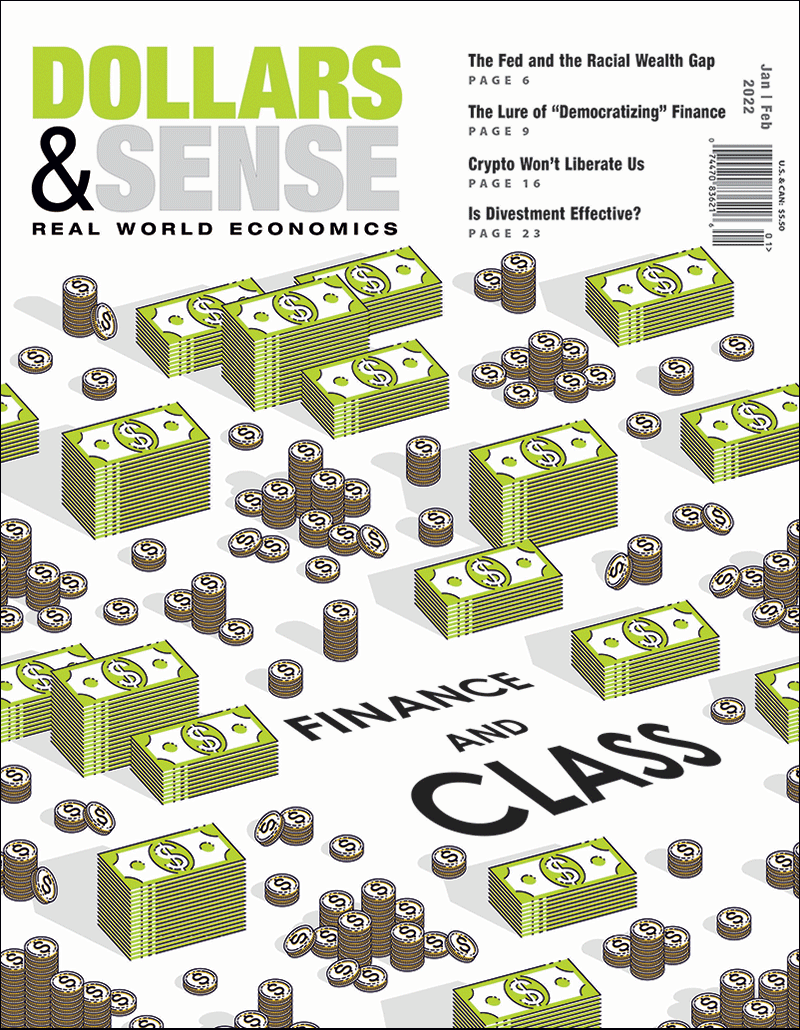Health Insurance for 20 Million is at Risk
If Congress fails to renew the ACA enhanced benefits, millions will be unable to access the health care they need.

Our very-late January/February issue is finally at the printers (and about to be sent to e-subscribers). Yesterday we posted the lead feature, by economist John Summa, The Lure of "Democratizing" Finance. Find the table of contents here. And here is the p. 2 editorial note:
In a recent article on “the meme stock revolution,” the Wall Street Journal reported that the twelve largest stock brokerage houses in the United States made a total of $3.8 billion in 2021—up 33% from 2020—for “selling their customers’ stock and options orders” to electronic trading firms. What does this mean, and how can stock brokerages make money doing it?
As John Summa tells it in his feature article on Robinhood Financial and last year’s “meme stock” bubble, brokerages like Robinhood sell their customers’ orders to wholesalers like Citadel LLC and Virtu Financial who fulfill the orders from murky “dark pool” inventories—but not at the better prices that customers would find in public exchanges like the New York Stock Exchange.
The kickback scheme, called “payment for order flow,” has been banned in other countries and was criticized in a recent Security and Exchange Commission report on last year’s social media-driven bubble. The scheme is also key to the story of how the supposedly “democratizing” trends in the investment world, like user-friendly smartphone apps that make trading stocks and options feel like a game, are drawing in millions of newbie investors only to have their money siphoned off by Wall Street insiders whose profits swell with rising trading volume.
Variations on this story are told over and over in our special issue on finance and class: Financial markets are supposed to direct savings to productive investment, but in practice they redirect ordinary people’s savings to the pockets of big-money interests. And innovations in finance that are marketed as helping the little guy only reinforce the class dynamics in finance, where ordinary people risk their meager earnings in a casino where the house—Wall Street’s big financiers—almost always wins.
Hadas Thier’s feature on cryptocurrency traces those class dynamics, while debunking claims that the digital currencies are a liberatory “leaderless movement to unseat the plutocrats who have benefitted hand over fist from our centralized banking system.” Thier demonstrates that, far from undermining plutocracy, cryptocurrencies exacerbate existing concentrations of wealth and power. And on top of that, the digital “mining” technology they depend on is enormously environmentally destructive.
Doug Orr talks about one of the ways that ordinary people can use finance to fight back against bad corporate actors—especially via “labor’s capital,” pension funds. But he argues that one of the strategies that activists favor—calling on institutional investors to divest from problematic industries like fossil fuel and private prisons—is not as effective as using investment funds as leverage to change firms’ behavior.
Bill Barclay walks us through the world of financial derivatives, from futures and options to the alphabet soup of derivatives that we remember (sort of) from the Great Financial Crisis—MBSs, CDOs, CDSs, etc.—with an historical primer that will arm us for the next time that these “financial instruments”—tools of the financiers—come back to bite us. And they inevitably will, since trading volume is up and the murky over-the-counter trading that led to the last crisis is still under-regulated.
Our columnists provide context: John Milleron the Fed’s proposal for a “racial equity mandate” at a time when the Fed is feeling pressure to end its low-interest “easy money” policies; Ed Ford gives a refresher on how concentrated stock ownership is; and Arthur MacEwan addresses how the growth of the financial sector has worked with other factors to generate massive inequality.
Since finance is even more jargon-filled than other topics we cover in Dollars & Sense, we’ve made a special effort to highlight our authors’ definitions and explanations of specialized terms. And we called on cartoonist Masheka Wood, who has illustrated two prior issues on big-money investors and corporations, to illustrate this issue’s features on cryptocurrency and derivatives. We hope that, together, these articles help show how for-profit finance benefits big-money interests at the expense of the rest of us—perhaps especially when it claims otherwise.